These TS 10th Class Biology Chapter Wise Important Questions 5th Lesson Coordination will help the students to improve their time and approach.
TS 10th Class Biology Important Questions 5th Lesson Coordination
1 Mark Questions:
Question 1.
A plant which grows near a window bends towards Sunlight. Write the reason for it.
Answer:
Auxins are the plant hormone responsible for the growing of the stem towards light. Auxins are synthesized at the tip of the stem. Bending of the plant towards light is called phototropism by the action of auxine to show response towards the sunlight.
Question 2.
Write the name of the nerve given in the following diagram and write its function.
Answer:
The given diagram is the Sensory Neuron. They are also called Afferent nerves.
Function : They carry messages towards central nervous system (Brain or spinal cord) from nerve endings on the muscles of different sense organs. They detect ‘stimuli’ or the change in surroundings.

Question 3.
Identify the given part in the diagram and write its use.
Answer:
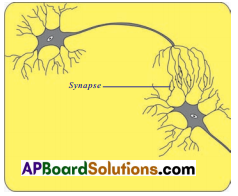
- Synapse.
- k is a functional region of contact between two neurons where information from one neuron is transmitted to another neuron.
Question 4.
Name the part of the brain that maintains the equilibrium.
Answer:
The part of the brain that maintains the equilibrium is cerebellum.
![]()
Question 5.
You may eat grapes with no seeds. How they are formed? Write some other fruits names.
Answer:
Grapes without seeds are produced by an asexual method called parthenogenesis. Watermelon, pomegranate.
Question 6.
How many types of nerves are there ? What are they?
Answer:
On the basis of pathways followed, nerves are classified mainly into three types.
- Afferent Neurons
- Efferent Neurons
- Association Neurons.
Question 7.
What are Afferent neurons?
Answer:
Nerves which carry messages towards the central nervous system (spinal cord or brain) from nerve endings on the muscles of different sense organs that sense the change in surroundings are called Afferent nerves. These are also called ‘sensory’ nerves.

Question 8.
What are Efferent neurons?
Answer:
The nerves which carry messages from the central nervous system to parts that shall carry out the response or the effectors (muscles) are called efferent neurons. They are also called ‘motor’ nerves.

Question 9.
What are association nerves?
Answer:
These nerves which link together the afferent and efferent nerves are called association nerves.
Question 10.
What are reflexes?
Answer:
The responses which we may not have a control are called reflexes.
Question 11.
What is a Reflex arc?
Answer:
Picking up information of a stimulus to generate a response involves a pathway from detectors to brain or spinal cord or a set of nerve cell heads near spinal cord to the effectors. Such a single pathway going up to the spinal cord from detectors and returning to effectors is a reflex arc.
Question 12.
What are unconditioned reflexes?
Answer:
There are some responses which are inborn and inherited from the parents. These are called unconditioned reflexes.
Ex: Withdrawing the hand when you touch fire.
Question 13.
What are conditioned reflexes?
Answer:
Conditioned reflexes are not inherited. These reflexes develop in an organism by repeated exposure to the similar stimuli.
Ex: Standing in attention, when you hear National Anthem.
Question 14.
What are the components of central nervous system?
Answer:
Central nervous system includes brain and spinal cord.
Question 15.
What are the divisions of brain ?
Answer:
The divisions of brain are:
- Fore brain – cerebrum, diencephalon
- Mid brain – optic lobes
- Hind brain – cerebellum, medulla oblongata.
![]()
Question 16.
What is enteric nervous system?
Answer:
There is a system of neurons present in our digestive tract that can function even independently of either central nervous system or peripheral nervous system. It has been nick named as a small brain and the system is called as ENTERIC nervous system.
Question 17.
What is sympathetic nervous system?
Answer:
The sympathetic nervous system is formed by the chain of ganglia on either sides of the vertebral column and the associated nerves.
Question 18.
What is parasympathetic nervous system?
Answer:
The parasympathetic nervous system is formed by the nerves arising from the ganglia of the brain and the posterior part of the spinal cord.
![]()
Question 19.
Do plants also have control system?
Answer:
To control and coordinate the functions in plants also produce some chemical substances which are called hormones.
They are auxins, gibberellins, cytokinins, ethylene and abscisic acid.
Question 20.
What are voluntary actions ? Give examples.
Answer:
The movements under the control of the conscious mind (voluntary) are called voluntary actions.
Example: Kicking football, lifting bucket of water, lifting books, running, walking, playing, eating, etc., which are done with our knowledge.
Question 21.
What are involuntary actions ? Give examples.
Answer:
The movements which are not under the control of the conscious mind are called involuntary actions.
Example: Respiration, circulation, digestion, heart beating.
Question 22.
How do reflexes take place in our body?
Answer:
Reflexes are fast, immediate, automatic and involuntary responses of the body. They occur without our thinking. Brain is not involved in these actions.
Question 23.
How many types of actions are controlled by nervous system in our body?
Answer:
Two types of actions were controlled by nervous system. They are voluntary and involuntary actions.
Question 24.
How many types of reflexes are present?
Answer:
There are two types of reflexes.
- Unconditional reflexes
- Conditional reflexes.
Question 25.
What is the reaction of the body when we step on a sharp edged object?
Answer:
Our leg muscle responds immediately and raises up the leg, when we step over a sharp edged object.
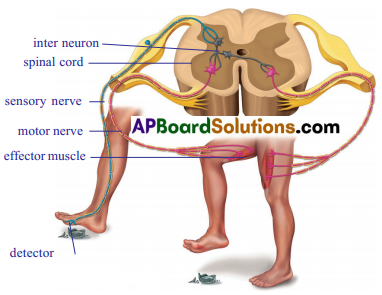
Question 26.
Why is a system of control and coordination essential in living organisms?
Answer:
- Increase the chances of survival by responding to stimuli.
- Different body parts function as a single unit.
- To maintain a homeostasis.
Question 27.
What will happen when plant is exposed to unidirectional light?
Answer:
Stem bends towards unidirectional flow of light. It is called phototropism.
Question 28.
A part of the hind brain makes possible activities like walking, skating, riding a bicycle and picking up a pencil. Name this part of the hind brain.
Answer:
Cerebellum.
![]()
Question 29.
Name the plant hormone which inhibits growth and causes wilting of leaves.
Answer:
Abscisic acid.
Question 30.
Taking the example of heart beat, justify the antagonistic (opposite) action of the sympathetic and parasympathetic nerves.
Answer:
Sympathetic system increases contraction and rhythm and parasympathetic system decreases contraction and rhythm with respect to heart beat.
Question 31.
Name the part of neuron where information is acquired.
Answer:
Dendrite.
Question 32.
Who transmits nerve impulse across the synapse?
Answer:
Neurotransmitters.
Question 33.
Why do leaves drop off seasonally?
Answer:
The leaves drop off seasonally as they stop producing auxins which normally prevent the formation of abscission zone that cuts off nutrients and water supply to leaves.
Question 34.
Have you ever observed the duration of anger?
Answer:
The duration of anger will be sometimes ten minutes or fifteen minutes or according to the situation.
Question 35.
What may happen if anger persists for a longer period?
Answer:
If anger persists for longer time, regular metabolic activities are disturbed.
2 Mark Questions:
Question 1.
Draw the diagram of nerve cell and label it.
Answer:
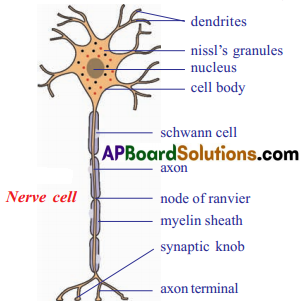
Question 2.
What is the significance of the adrenal gland in the human body?
Answer:
Adrenal gland secrets adrenalin. it helps in
- Increase heart beat rate
- Rise in blood sugar
- Dilation of the coronary artery
- Dilation of pupil of the eye.
![]()
Question 3.
Write the difference between hormone and enzyme.
Answer:
| Hormone | Enzyme |
| 1 These are secreted by ductless glands. | 1. These are secreted by duct glands. |
| 2. These are travel through blood. | 2. These are travel through the ducts. |
| 3. Less in quantity. | 3. More in quantity. |
| 4. Reaction is slow. | 4. Reaction is fast. |
| 5. Involved in metabolic activities | 5. Involve in digestion. |
| 6. Ex: Insulin | 6. Ex: Lypase |
Question 4.
What questions you will ask a neurologist on function of brain?
Answer:
- How does alcohol cosumption affect the brain?
- Which part of brain is responsible for creatMty?
- How do we get fits?
- How do we get paralysis?
- What kind of food should we take to increase I.Q.?
Question 5.
Label a, b, c, d in the diagram given below and write their functions.
Answer:

a. Sensory Neuron/Afferent Neuron: These carry messages towards the central nervous system.
b. Motor Neuron/Efferent Neuron : These carry messages from central nervous system to body parts.
c. White Matter
d. Effector Muscles: Respond to stimuli.
Question 6.
Observe the following table and answer the questions.
| Hormones | Uses |
| Thyroxine | Normal growth rate, effect on metabolism |
| Auxins | Cell elongation and differentiation of shoots and roots |
i. Name the phytohormone in the table.
ii. Name the hormone which Influences growth rate in humans.
Answer:
i. Auxin
ii. Thyroxine.
Question 7.
Explain two tropic movements with suitable examples.
Answer:
- Phototropism: Response of plant to light cite example is called phototropism.
Ex: sunflower - Geotroplsm : Response of a plant to gravitational force Ex: root growth of plant
- Hydrotropism: Response of root to water availability in the soil.
Ex: Plants which are growing very close to rocks and walls. - Thlgmotropism: Response to make contact or touch is called Thigmotropism.
- Chemotroplsm : Response to chemical is called chemotropism (Stigma secretes sugary substances)
Question 8.
Prepare a table showing tropic movements in plants in response to stimuli.
Answer:
| SI. No. | Tropic movement | Response to stimuli |
| 1. | Phototropism | Movement towards light. |
| 2. | Geotropism | Respond positively for gravitational force. |
| 3. | Hydrotropism | Roots grow towards presence of water in the soil. |
| 4. | Thigmotropism | Tendrils and climbing plants grow towards support. |
Question 9.
Write two voluntary functions and two involuntary functions you have observed in your body.
Answer:
a. Examples for voluntary functions:
- Cleaning the table
- Playing on the keyboard.
b. Examples for involuntary functions:
- Salivating when food is kept in the mouth
- Closing of eyes when bright light is focussed.
Question 10.
Plants shows tropic movements in different situations. Give examples.
Answer:
1. Movement of individual parts of plants is possible when they are subjected to external stimuli. This type of response is called tropism or tropic movement.
2. The response of a plant to light is called phototropism. Respond of plants for gravity is called geotropism. Movement of plant towards water is called hydrotropism. The type of response by plants to make contact or touch is called thigmotropism. The response of plants to chemicals is called chemotropism.
![]()
Question 11.
Divide the following into groups. Walking, blinking of eyelids, heart beat, laughing, digestion of food and reading. How do you divide them into groups?
Answer:
These can be divided into voluntary actions, involuntary actions and reflex actions.
- Voluntary actions : Walking, laughing, reading
- Involuntary actions : Digestion of food, heart beat
- Reflex actions : Blinking of eye lids
Question 12.
What are the differences between unconditioned and conditioned reflexes?
Answer:
| Unconditioned reflexes | Conditioned reflexes |
| 1. They are inborn reflexes. | 1. They are not inherited. These are learned by doing the same at several times. |
| 2. They are inherited shown from the birth. | 2. These have to be learned by the organism. |
| 3. These are present in all individuals and are basically same. | 3. They are not same in all individuals. |
| 4. Ex: With drawing the hand when you touch fire. | 4. Ex: Standing in attention when you hear National Anthem. |
Question 13.
Write the components of reflex arc and their functions.
Answer:
- The structural and functional unit that carries out reflex action is called a reflex arc.
- It consists of five components.
- They are receptor, a sensory nerve, a association neuron, a motor nerve and an effector organ.
| SI. No. | Component of reflex arc | Functions |
| 1. | Receptor | Receives information and generates impulses. |
| 2. | Sensory neuron (Afferent) | Carries information from the receptor to the interneurons in the spinal cord. |
| 3. | Interneuron (Association neuron) | Processes the information and generates responses. |
| 4. | Motor neuron (Efferent) | Carries the information from the spinal cord to the effector organ. |
| 5. | Effector organ | Receives the information from the efferent neuron and shows the appropriate responses. |
Question 14.
How is brain in the human beings protected from injuries?
Answer:
- Brain is a very soft tissue and is surrounded by a bony case called cranium, which is made up of skull bones.
- Cranium protects the brain from injuries.
- Brain is covered by three membranes – Dura matter, Archnoid membrane and pia matter. They give protection to the brain.
- The cerebro – spinal fluid which flows between the outer and middle membranes, protect the brain from injuries and also the cerebro-spinal fluid provides nutrients to the brain and spinal cord.
Question 15.
What are plant growth substances ? Give examples.
Answer:
- Plant growth substances are the chemical (organic) substances which are produced in plants and act at minute concentration on growth and other phisiological functions of plants.
- There are five major types of plant growth substances. They are auxins, gibberellins, cytokinins, ethylene and abscisic acid.
Question 16.
What are the functions of cytokinins?
Answer:
- Cytokinins are capable of stimulating cell division along with auxins.
- They promote cell elongation.
- They have ability to delay the process of ageing in leaves.
- Cytokinins can prolong the life of fresh-leaf crops like cabbage, spinach.
- They are also used for keeping the flowers fresh.
- Cytokinins are most effective in breaking dormancy of buds and seeds.
- The levels of cytokinins decrease in senescing leaves.
![]()
Question 17.
What is ABA Explain its function in the plant.
Answer:
- ABA means Abscisic acid. It is the plant growth inhibiting substance.
- It Induces dormancy in buds, tubers and many seeds.
- ABA is responsible for the formation of separation layer or abscission layer between main plant and the leaf or between plant and flower or fruit. It results in the falling of leaves, fruits and flowers.
- It prevents the water loss during drought conditions by closing the stomata.
Question 18.
What is ethylene ? Explain its action.
Answer:
- Ethylene is a gaseous growth inhibiting substance.
- Ethylene causes ripening of the fruits.
- It modifies the growth of the plant by inhibiting stem elongation.
- It accelerates abscission of leaves, flowers and fruits.
Question 19.
How do living organisms respond to the changes in the environment?
Answer:
- All living organisms have a mechanism to identify the changes in the environment and respond to the changes.
- There are specific cells in the organisms which have ability to respond to the environmental changes.
Question 20.
Why are samepaileirs of diabetes treated by giving injections of insulin?
Answer:
- Diabetes is a condition in which sugar level in blood is very high.
- Insulin hormone is released by pancreas glands which regulate the blood sugar level.
- In diabetic patients pancreas is stopped releasing insulin hormone.
- In it is not secreted in proper amounts, the sugar level in the blood rises, causing many harmful effects.
- Due to this reason diabetic patients are treated by giving injections of insulin.
Question 21.
On touching a hot plate you suddenly withdraw your hand. Which category of neurons become active first and which are next?
Answer:
- On touching a hot plate, first the sensory organs are activated which take the information to the brain or the spinal card.
- Next the motor neurons become active and bring the impulses from the brain to the muscles.
- In receiving these impulses, the muscles contract and the hand is immediately removed from the hot plate.
Question 22.
How does the plant shoot bend, when the plant is placed in a room having only one open window?
Answer:
- When the plant is placed in such a room that has only one open window, the shoot of the plant bends towards the direction of light.
- Plant hormone auxin is formed that diffuses towards the shady side of the shoot and stimulates the cells to live longer on the side of the shoot which is away from light.
- In this way the shoot bends towards the light.
Question 23.
Give a reason to explain why adrenaline helps in dealing emergency situations.
Answer:
- Adrenaline increases the heart beat and breathing rate which results in the supply of more oxygen to muscles.
- It reduces the blood to the digestive system and skin as a result the blood is further diverted to skeletal muscles.
- All these responses together prepare the body to leal with the emergency situations.
Question 24.
Rami, has met with an accident. After that he has lost the capacity to
i. walk in straight line
ii. smell anything
iii. does not feel full eating.
Which part of brain is damaged in each case?
Answer:
i. Cerebellum is hurt which affects walking in straight line.
ii. Smelling part of fore brain is injured.
iii. The sensation of feeling full eating is because of a centre associated with hunger, which is in a separate part of the fore brain. The sensation of feeling full is not because of injury to this centre present in fore brain.
![]()
Question 25.
What is the difference between a reflex action and walking?
Answer:
| Reflex action | Walking |
| 1. It is a spontaneous immediate response to a stimulus. It happens without thinking. | 1. It is a response to the information transmitted by nerves to muscles of the legs. In this case thinking is involved. |
| 2. Keflex action is controlled and coordinated by spinal cord. | 2. Hind brain instructs and controls leg muscles to move. |
| 3. It is an involuntary action. | 3. It is a voluntary action. |
Question 26.
How do you feel when you realize that plants respond to the stimuli of their surroundings ?
Answer:
- It is very interesting and amazing to observe trophic and nastic movements of plants in our surroundings.
- For example, the bending of shoots of creepers towards light kept near the window.
- The plant roots always grow downwards.
- The creepers like cucumber and bitter gourds develop tendrils in response to contact or touch.
- Butterflies fluttering around the flowers for nectar.
Question 27.
Why is anger short living factor ?
Answer:
Anger is always short lived factor. Increased levels of adrenalin are responsible for anger. When the levels of adrenalin in the blood come down slowly. The anger also comes down. We came to normal state.
Question 28.
What will happen if it is continued for longer periods of time ?
Answer:
The sugar levels in the blood rise than normal level. Blood pressure increases, burning sensation in the heart, stomach upsets are the some of the abnormal conditions may happen.
4 Mark Questions:
Question 1.
Analyze the information given below. Write answers to the questions given below.
| Hormones | Uses | |
| Auxins | Cell elongation, differentiation of shoots and roots. | |
| Cytokinins | Promote cell division, delaying the ageing in leaves, opening of stomata. | |
| Gibberellins | Germination of seeds, sprouting of buds; elongation of stem; stimulation of flowering; development of seedless fruits, breaking the dormancy in seeds and buds. | |
| Abscisic acid | Closing of stomata; seed dormancy, promoting ageing of leaves. | |
| Ethylene | Ripening of fruit. | |
i. What are Phytohormones ? Write the names of two phytohormones.
Answer:
Phytohormones: The hormones present in the plants are called phytohormones.
Names of phytohormones: Auxins, Cytokinins, Gibberellins, Abscisic acid, Ethylene
ii. Which hormone is responsible for closing of stomata and which hormone acts against it ?
Answer:
- Abscisic acid is responsible for closing of stomata.
- Cytokinin acts against it.
iii. What are the functions performed by abscisic acid ?
Answer:
Functions of abscisic acid :
- Closing of stomata
- Seed dormancy
- Promotes the ageing of leaves.
![]()
iv) Which hormones help in the growth ?
Answer:
Auxins, Gibberllins and cytokinins help in the growth.
Question 2.
Observe the following information and answer the following questions.
| S.No. | Hormones | Uses |
| 1. | Auxins | Cell elongation and differentiation of shoots and roots. |
| 2. | Abscisic acid | Closing of stomata, seed dormancy |
| 3. | Ethylene | Ripening of fruit |
| 4. | Cytokinins | Promote cell division, promote sprouting of lateral buds, delay ageing of fruits. |
i. What do we call the hormones that are present in plants?
Answer:
We call phyto hormones which are present in plants.
ii. Name the hormones which are helpful In the growth of the plants.
Answer:
Auxins, gibberellins, cytokinins are helpful in the growth of the plants.
iii. Farmers keep carbide powder in between raw mangoes. What might be the reason? What will be the end result after 3 to 4 days?
Answer:
Carbide release Ethylene, which promotes the fruit ripening. After 3 or 4 days fruits will ripen.
iv. Plants also respond like animals. Do you agree with this statement ? Support your answer.
Answer:
Yes, plants also respond like animals. They shut off leaves in summer, germinate in rainy season, blooms according to seasons.
Question 3.
What are the divisions In the brain? What are their functions?
OR
Explain the different parts of the brain and their functions in a table form.
OR
Write in a tabular form the different parts of human brain and their functions.
Answer:
1. Brain has the following divisions.
- Fore brain – Cerebrum, diencephalon
- Mid brain – Optic lobes
- Hind brain – Cerebellum, medulla.
2. Functions of the various parts of the brain.
| Parts of the brain | Functions |
| Cerebrum | i. Seat of mental abilities, controls thinking memory, reasoning, perception, emotions and speech. ii. Interprets sensations and responds to cold, heat, pain and pressure. |
| Diencephalon | i. Relay centre for sensory impulses, such as pain, temperature and light. ii. Reflex centre for muscular activities. iii. Centre for certain emotions such as anger. iv. Centre for water balance, blood pressure, body temperature, sleep and hunger. v. The hypothalamus controls the pituitary gland, which functions as the master gland |
| Mid brain | i. It relays motor impulses from the cerebral cortex to the spinal cord and relays sensory impulses from the spinal cord to thalamus, reflexes for right and hearing. |
| Cerebellum | i. Maintains posture, equilibrium and muscle tone. ii. Coordinates voluntary movements initiated by cerebrum. |
| Medulla oblongata | i. Contains centre for cardiac, respiratory and vasomotor activities. ii. Coordinate reflexes like swallowing, coughing, sneezing and vomiting. |
Question 4.
Read the following table and answer the questions given below.
Answer:
| S.No. | Name of the gland | Location | Hormone secreted | Response of the body to hormone |
| 1. | Pituitary | Floor of brain | Somatotropin | Growth of bone. |
| Gonadotropin | Activity of ovary and testis. | |||
| 2. | Thyroid | Neck | Thyroxine | General growth rate and metabolic activity. |
| 3. | Ovary | Lower abdomen | Estrogen | Growth of the uterus and skeleton of the pelvis. |
| 4. | Testis | Scrotal sac | Testosterone | Growth of male secondary sexual characters. |
1. Write the importance of glands and hormones.
Answer:
Glands and hormones controls and coordinates various functions of the body with nervous system.
2. Which hormone Is responsible for growth of bone?
Answer:
Somatotropin is responsible for growth of bone.
3. What happens if testosterone is not secreted?
Answer:
Secondary sexual characters are not developed if testosterone is absent.
![]()
4. Where is the gland that secretes thyroxine located?
Answer:
Thyroid gland which secretes thyroxine is located near the neck.
5. Which glands are common in male and female?
Answer:
Pituitary, thyroid, adrenal glands are common in male and female.
Question 5.
Explain the different types of adaptations in plants with suitable examples.
Answer:
- Most plants can aerate their roots by taking in the oxygen through the lenticels or through the surface of their root hairs
- But plants which have their roots in very wet places, such as ponds or marshes, are unable to obtain oxygen.
- They are adapted to these water-logged conditions by having much larger air places which connect the stems with the roots, making diffusion from the upper parts much more efficient.
- The most usual adaptation is to have a hollow stem.
- The problem of air transport is more difficult for trees.
- An exception is the mangrove tree of the tropics which have aerial roots above the soil surface and takes in oxygen through these roots.
Question 6.
Which system of our body is called second brain ? Why?
Answer:
1. Enteric nervous system is called “second brain”.
2. The neural apparatus of our digestive tract comprises of such a vast and complicated network of neurons.
3. Nervous system of gut is not only constricted to digestion or inflict the occasional nervous pang of hunger, but also mass of neural tissue is filled with important neurotransmitters.
4. Enteric nervous system is connected with big brain in our skull.
5. It determines our mental state and plays key role in certain diseases throughout the body.
6. The digestive tract is exposed to a large variety of psychochemical stimuli from the external working in the form of ingested food.
7. The intestine act as a rich store of coordinated moments of its muscular apparatus along with the neural apparatus.
8. Enteric nervous system consists of sheaths of neurons in the walls of our gut, which measures about 9 meters from the oesophagus to Anus. So it is called enhene nervous system.
9. Second brain involves in stimulating and coordinating breaking down of food, absorbing nutrients, and expelling of waste requires chemical processing, mechanical mixing and rhythmic muscle contractions.
10. It equipped with its own reflexes and senses, the second brain can control several gut functions often independently of the brain.
Question 7.
Karthik is suffering from excess sugar in urine and Varun is suffering from repeated dilute urination. What are the reasons for these diseases? Explain.
Answer:
- Excess sugar in urine condition is known as diabetes milletus. (sugar diabetes)
- Repeated dilute urination is known as diabetes insipidus. (diuretic condition)
- Deficiency of insulin causes high level sugar in the blood and urine. It leads to diabetes milletus. (Sugar diabetes)
- Vasopress in maintains osmotic concentration of body fluids.Deficiency of vasopress in causes excessive repeated dlilute urination it is called as diabetes insipidus.
Question 8.
Analyse the following information and answer the questions.
| SI. No. | Organ | List-1 Effect of Nervous system |
List-2 Effect of Nervous system |
| 1. | Eye | Dialates pupil | Constricts pupil. |
| 2. | Mouth | Inhibits salivation | Stimulates salivation |
| 3. | Lungs | Relaxes bronchi | Constrict bronchi. |
| 4. | Heart | Accelerates heart beat | Heart beat to normally. |
| 5. | Blood vessels | Increase blood pressure | Decrease blood pressure. |
| 6. | Pancreas | Inhibits Pancreas activity | Stimulates Pancreas activity. |
i. Write two functions of Sympathetic Nervous System.
ii. Name two organs that are Influenced by Parasympathetic Nervous System.
iii. Name the Nervous system mentioned in the table that Increases the blood pressure.
iv. What systems constitute Autonomous Nervous System?
Answer:
i. Dilates pupil, inhibits salivation, relaxes bronchi, accelerates heart beat, etc.
ii. Eye, heart, pancreas, etc.
iii. Sympathetic nervous system
iv. Sympathetic and para sympathetic nervous system.
Question 9.
Explain the Phytohormones which controls growth in plants.
Answer:
Major plant hormones and their action :
| Hormones | Uses |
| Auxins | Cell elongation and differentiation of shoots and roots. |
| Cytokinins | Promote cell division, promotion of sprouting of lateral buds, delaying the ageing in leaves, opening of stomata. |
| Gibberellins | Germination of seeds and sprouting of buds; elongation of stems; stimulation of flowering; development of seedless fruits, breaking the dormancy in seeds and buds. |
| Abscisic acid | Closing of stomata; seed dormancy, promoting aging of leaves. |
| Ethylene | Ripening of fruit. |
Question 10.
Analyse the table and answer the following questions.
| Sl.No. | Part of Brain | Functions |
| 1. | Cerebrum | Mental abilities, memory, speech. |
| 2. | Diencephalon | Sensory impulses, emotional impulses, muscular activities. |
| 3. | Midbrain | Reflexes of sight and hearing. |
| 4. | Cerebellum | Equilibrium. |
| 5. | Medulla oblongata | Respiratory, cardiac centres, blood pressure. |
i. Which part of the brain recollects the childhood incidents?
Answer:
Cerebrum.
![]()
ii. Write two parts of hind brain.
Answer:
Cerebellum, med ulla oblongata.
iii. Name the part of the brain that will not function in drunken person.
Answer:
Cerebellum.
iv. Name the part of the brain that controls involuntary actions.
Answer:
Medulla oblongata.
Question 11.
Write contrasts and comparisons of the style of response in plants and animals to the stimuli.
Answer:
- Both plants and animals react to various stimuli around them. But the method of responding to stimuli is not similar in plants and animals.
- Higher animals respond to stimuli because they have a nervous system and an endocrine system.
- Plant do not have a well defined nervous or endocrine system. They do have some mechanism of control by means of some chemicals or hormones.
- Plants can sense the presence of stimuli like light, heat, water, touch, pressure, chemicals, gravity, etc.
- The hormones present in the plants called phytohormones control response towards the stimuli. Phytohormones coordinate the activities of the plant usually by controlling one or the other aspect of the growth of the plant.
Question 12.
Read the below paragraph and write answers.
There is systematic method in showing response to stimuli. There is different stages in it. First stage starts with the response recognising the changes in out-side or inside of the body atmosphere with recognising the stimuli. Transmitting the received information is second stage, analysing that information is third stage and showing correct response to that stimuli is the last stage.
a. What does this information show ?
b. Convert the above information into flow chart.
c. Write about the mechanism that conducts this action.
A.
a. It shows the systematic method in showing response to stimuli.
b.
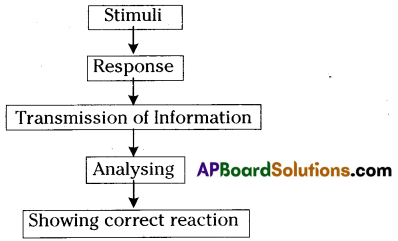
c. Nervous system can sense the changes inside and outside the body through specialised cells called Receptors. This information in the form of small electrical currents is analysed and responses are generated in the nervous system. These responses once again in the form of small electrical currents are conveyed to the appropriate organs such as muscles and glands at a greater speed. Nervous system may store this information for future use.
Question 13.
See the below action. What does it indicate ? Explain with an example.
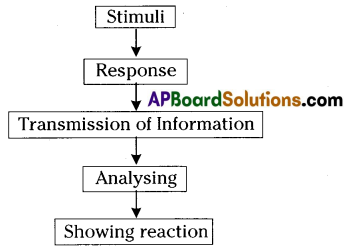
Answer:
It indicates the stimulus – response action. This stimulus response can be explained with an example. Suppose a mosquito is biting you on your arm. Mosquito bite is stimulus. The receptor in the skin responds and send the information in the form of electrical impulses through sensory nerve to spinal cord or brain.
Brain or spinal cord analyses the information that the mosquito bite is causing pains. The brain or spinal cord sends the message through motor nerve to the effector organ i.e. hand to kill the mosquito. As per the message our hand immediately hits the mosquito and kills it.
![]()
Question 14.
Describe the structure of brain.
OR
All the activities of human are controlled by a vital organ. With the help of a neat labelled diagram describe its structure.
Answer:
- When compare to body weight human brain quite large as compared to several other animals.
- The brain is present in the hard bony box like structure called cranium.
- It is covered by three layers called the meninges. The meninges are continued and coyer the spinal cord as well.

- It serves as a shock – absorbing medium and protects the brain against shocks / jerks along with meninges and cranium.
- The nerve cell bodies together with capillaries form a mass called grey matter while the inyelinated axons form white matter.
- The grey matter is in the outer layers while the white matter is present towards inner layers.
Question 15.
Describe the structure of spinal cord.
Answer:

- Spinal cord extends from the back of the hind brain (medulla oblongata) to the back of the stomach or lumbar region.
- It is cylindrical in shape. It passes through the neural canal of the vertebral column.
- The white matter is towards periphery, while grey matter is towards the centre of the spinal cord.
- In the cross-section, grey matter of the spinal cord is in the form of ‘H’ and it is called ‘horn’.
- In the middle of the grey matter of the spinal cord, there is a canal called spinal canal which is filled with Cerebro-spinal Fluid.
- From the sides of spinal cord 31 pairs of nerves arise and supply branches to various parts of the body.
- Function of spinal cord is receiving and sending information from brain to various parts and from various parts to brain. And it also helps in reflex actions.
Question 16.
What were the studies of the experimentalists on spinal cord?
Answer:
- The role of spinal cord in nervous control was studied largely by the experimentalists of the sixteenth and seventeenth centuries.
- They found that the Greeks concept of the brain was erroneous. Animals have shown to have the ability to respond to stimuli even when the brain was removed.
- The animals still produced muscular movements if it’s skin was pinched or pricked.
- The observers ‘Leonardo Davinci’ and ‘Stephen Hales’ recorded that the animal died as soon as spinal cord was damaged by pushing a needle down it.
- It is suggested that the spinal cord was not simply a trunk road for instructions from the brain but might be a control center in it’s own right.
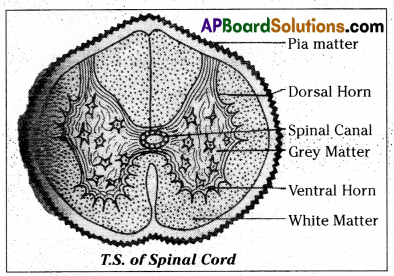
Question 17.
What do you understand by peripheral nervous system?
Answer:
- The peripheral nervous system consists of nerves that arise from the brain and spinal cord.
- The peripheral nervous system has 43 pairs of nerves of these 12 pairs are called CRANIAL NERVES and the rest of 31 pairs are called SPINAL NERVES.
- The grey matter of the spinal cord appears like butterfly or in the shape of letter ‘H’. Each segment of the ‘H’ shaped grey matter is called ‘HORNS’.
- The upper horns are called ‘DORSAL HORNS’ and the lower horns are called ‘VENTRAL HORNS’
- The sensory fibres originate from the dorsal horn of the spinal cord. They carry information from body organs to spinal cord.
- The motor fibres take their origin from the ventral horns of the spinal cord. These supply information required for the movements of the muscles.
Question 18.
Give an example of autonomous nervous system.
Answer:
Certain involuntary functions (without our knowledge) are controlled by autonomous nervous system takes place in our body. A very evident observation is the reduction and expansion of the pupil of our eye. When we enter a dark room, we cannot see anything immediately. Slowly we are able to see the things around us in the room. This is because of increase in diameter of pupil, which allows more light in.

When we come out of the dark room into broad day light, the diameter of the pupil decreases allowing less light to enter into the eyes. Both these functions are under the influence of the autonomous nervous system.
Question 19.
Give an example of autonomous nervous system.
Answer:
Certain involuntary functions (without our knowledge) are controlled by autonomous nervous system takes place in our body. A very evident observation is the reduction and expansion of the pupil of our eye. When we enter a dark room, we cannot see anything immediately.
Slowly we are able to see the things around us in the room. This is because of increase in diameter of pupil, which allows more light in. When we come out of the dark room into broad day light, the diameter of the pupil decreases allowing less light to enter into the eyes. Both these functions are under the influence of the autonomous nervous system.
![]()
Question 20.
Explain how coordination takes place without nerves by the story of Insulin.
Answer:
In 1868 Paul Langerhans, professor of pathology at the university of Freburg in Germany, working on the structure of the pancreas, noted certain patches of cells quite different in appearance from the normal tissue cells of the organ and richly cupplied with blood vessels. They are known islets of Langerhans, but their function remained unknown.
When pancreas is removed from the body of experimental animal, it was found that the animal developed a well-known human ailment ‘sugar diabetes’. It is a cause in man was unknown, but evidence pointed to the pancreas as a possible role.
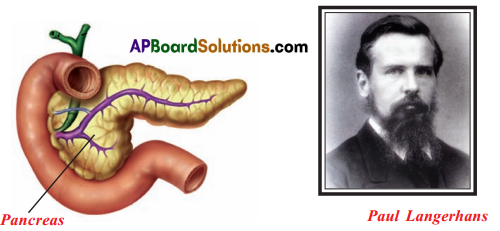
The animal treated with pancreatic Langerhans would not develop diabetes. This was really a strong evidence that the level of blood sugar is linked with the islet cells. The chemical substance secreted by these cells is the hormone insulin.
We can understand that the coordination also can be brought by the hormones, which are directly liberated into the blood. Insulin is now produced in large quantities for the treatment of human sufferers from sugar diabetes, to whom it is administered by injection into the skin.
Question 21.
What are endocrine glands ? Mention their functions.
Answer:
Endocrine glands : Endocrine glands are the ductless glands. They secret complex organic substances called hormones directly into the blood. Hormones are transported through blood to different tissues. Their secretions act as biochemical messengers in the body.
Functions : The hormones secreted by these glands play an important role in co-ordinating various organ systems. Hormones can increase or decrease the metabolism and synthesis of substances like proteins, carbohydrates and lipids. Irregular functioning of these glands may lead to serious diseases. The quantity of hormone required is very minimum (1/10,00,000 gram). A slight increase or decrease may brings out large changes in the target tissue
Question 22.
What is feedback mechanism ? Explain.
Answer:
1. A feedback mechanism is a loop in which a product controls its own production.
2. The production of several hormones is controlled in this manner.
Example 1.
- A pituitary hormone, ‘prolactin’ stimulates mammary glands to produce milk.
- As the baby sucks, more prolactin is produced enhancing milk production.
Example 2.
- When the glucose level in blood rises above normal level certain cells of pancreas respond by producing more amount of insulin hormone into the blood effectively lowering blood glucose levels.
- Lowering to normal level results in turning down the secretion of the hormone.
- If the glucose level comes back to normal level secretion of insulin is automatically reduced. There are also ways in which hormonal secretion may also enhance the production of product and vice versa.
Question 23.
What is autonomous nervous system ?
Answer:
The system that helps to bring about activities of internal organs is called autonomous nervous system. Example : heart beat, breathing, etc. Autonomous nervous system consists of nerve centres called GANGLIA. From these nerve centres nerves are given off to the various organs like heart, lungs, kidneys, alimentary canal and muscles.
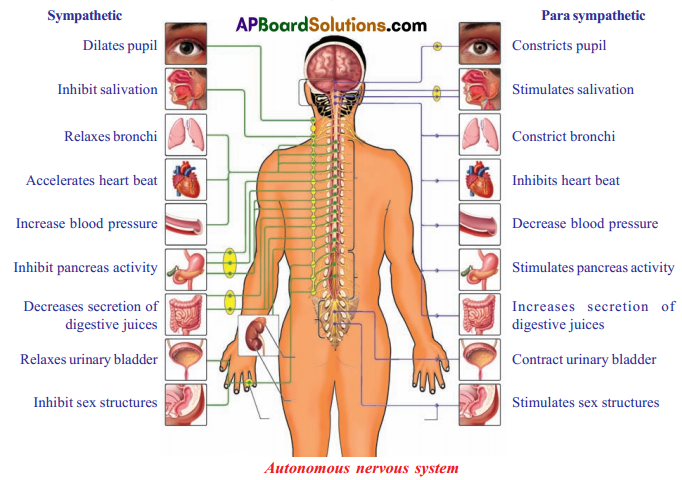
The autonomous nervous system is automatic and involuntary. It controls the involuntary actions of heart, the working of the lungs, movement of muscles in the alimentary canal and others. The autonomous nervous system is divided into parasympathetic nervous system and sympathetic nervous system.
Question 24.
Write differences between nastic and tropic movements.
| S.No. | Nastic movements | Tropic movements | |
| 1. | Growth | Growth independent movements | Growth dependent movements |
| 2. | Time of action | Immediate | Slow |
| 3. | Response to stimulus | Non-directional | Directional |
| 4. | Reason for action | Change in turgor | Cell division |
| 5. | Alternate name | Nasties | Tropism |
| 6. | Examples | Folding of leaves of touch me – not (mimosa), opening and closing of stomata. |
Phototropism, geotropism, hydropism, chemotropism. |
Question 25.
On the basis of pathways, how many types of nerves are there ?
Answer:
On the basis of pathways followed, nerves are classified mainly into three different types. They are :
- Afferent Neurons
- Efferent Neurons
- Association Nerves.
1. Afferent Neurons: They carry messages towards the central nervous system (brain or spinal cord) from nerve endings on muscles of different sense organs that sense the change in surroundings are called stimulus detectors. These are also called ‘sensory’ nerves.
2. Efferent Neurons : They carry messages from the central nervous system to the parts that shall carry out the responses. They are also called “motor” nerves.
![]()
3. Association Nerves : They link together the afferent and efferent nerves.
II. Asking Questions And Making Hypothesis
Question 1.
Can you imagine how it (the tendrils of plants growing towards a support) is happening ? Would you think it is a responding to a stimulus ?
Answer:
Plants also can response to stimulus. They can sense the presence of stimulus like light, heat, water, touch, pressure, chemicals, gravity, etc.
The hormones present in the plants are called phytohormones. These control responses towards the stimuli.
Question 2.
What will happen if intake of iodine in our diet is low ?
OR
Why is the use of iodised salt advised ?
Answer:
1. It is advised to use iodised salt to prevent goitre (enlargement of the thyroid gland).
2. Iodine is required for the proper functioning of thyroid.
3. Iodine stimulates the thyroid gland to produce thyroxin hormone.
4. This hormone regulates carbohydrate, fat and protein metabolism in our body.
Question 3.
What happens if testis and ovary do not function properly ?
Answer:
- If the testis does not work properly Testosterone may not secrete, as a result secondary sexual characters like growth of hair on face, muscular development, deepening of voice, normal sexual behavior and development of male sex organs may not takes place.
- If ovary does not work properly Estrogen and Progesteron may not secrete as a result growth of the uterus and skelton of the pelvis may not take place.
- Menstrual cycle may not take place in female, as a result ovary may not release and children may not occur.
Question 4.
If you get a chance to met a neurologist/neurophysician, what type of questions will you ask to keep your Nervous System healthy ?
Answer:
To keep our nervous system healthy I will ask following questions.
- What kind of diet you will suggest to keep our nervous system healthy ?
- What is meant by brain stroke ?
- How does paralysis occur ?
- What are the reasons for paralysis ?
- Why polio (patients) is not curable ?
- Why some people do creative works easily, when compared to others ?
- Why cell division does not occur in neurons ?
- What are factors effect the nervous system ?
(You can add your own questions based on concept)
Question 5.
What Will happen if thyroid is removed ?
Answer:
- If thyroid is removed from body, tissue metabolism and growth may stop.
- Absorption of glucose will not takes place, as a result sugar levels will increase and ultimately it leads to health problems.
III. Experimentation And Field Investigation
Question 1.
Write the following items about the experiment you have done to show that plants move to light.
a. Used equipments
b. Method of the experiments
c. Observed results.
Answer:
a. Used equipments : Glass jar filled with soil, bean seed
b. Method of experiment:
Take a glass jar and fill with soil. Sow a bean seed near the wall of the jar. This helps us to observe how root and shoot are growing. After 4-5 days we will notice seed germination. Keep the jar under the sun – observe how root and shoot grows. Then fill the glass jar and keep the plant horizontally. Observe the direction of root and shoot growth for more than a week.
c. Observed results:
The shoot position (tip) of the plant grows towards light. It bends towards light. It is due to collection of more auxin on the light illuminated side of the stem. So cells on that side grow faster. On opposite side cells grow slow to make the stem bend.
Question 2.
Write brief notes on Ivan Pavlov’s experiment on dog to demonstrate conditioned reflexes.
Answer:
- Conditioned reflexes are not inherited.
- Ivan Pavlov, a Russian scientist did experiments on conditioned reflexes. His experiments on dogs have become very famous.
- When the dog sees food, it salivates. He rang a bell whenever the dog was given food.
- After doing this for few days he noticed that the dog salivates when it hears the bell even if the food is not given.
- In other words dog associated the sound of the bell with the food and assumes that whenever the bell rings food is given.
- In expectation of food, saliva starts flowing from its mouth. Human beings are no exception to this.
- For example, standing in attention when you hear National Anthem.
Question 3.
What experimental procedure will you follow to prove phototropism and geotropism in germinating seeds ?
Answer:
Aim : To show phototropism and geotropism in germinating seeds.
Apparatus : Glass jar, soil, bean seed, water.
Procedure:
- Take a glass jar with soil. Sow a bean seed near the wall of the jar.
- After 4-5 days you will notice seed germination.
- Keep the jar under sun. Observe how roots and shoots grow.
- Then tilt the glass jar and keep the plant horizontally for more than 1 week.
Observation :
- Observe the plantlet when plant keeps errect. Shoot will grow towards sun and root towards gravity (soil).
- When keep the plant horizontally, after one week you observe that shoot take tilt grow towards sun and root will grow towards gravity.
IV. Information Skills And Projects
Question 1.
Rangaiah is not feeling well. The following results have come in the tests. Analyse the table. Write answers for the following questions.
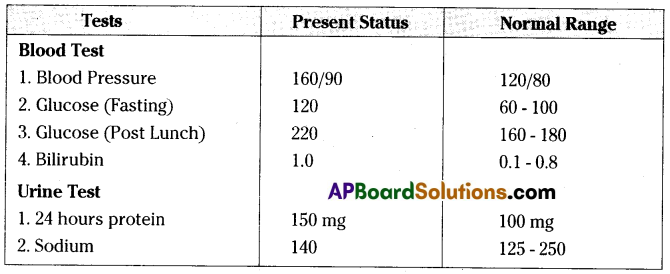
1. How can you state that Rangaiah is diabetic?
2. What are the tests to know about Biliru bin?
3. What do you understand from the above report?
4. What questions do you ask the doctor on the above report?
Answer:
1. After blood test it was found that level of glucose (Fasting) is 120 whereas the normal range is 60 – 100. After lunch the level of glucose in blood of Rangaiah further raised to 220, the normal being between 160 – 180. This shows that Rangaiah is diabetic.
2. We can know about bilirubin by blood test.
![]()
3. It shows that Rangaiah is diabetic and his systolic pressure ¡s slightly high. The levels of bilirubin ¡n blood also slightly high, almost normal range. Urine test shows sodium levels and at normal range but 24 hours protein is much higher than normal levels.
4.
- What are symptoms shown by Rangaiah as diabetic patient?
- What are the ways to control sugar in the blood?
- Which hormone is responsible for raise of glucose in the blood?
- How sodium maintains blood pressure at normal levels?
- What is the role of bilirubin in digestion?
Question 2.
Write the list of questions to ask the manager of the garden of your village to know which plants are grown through grafting.
Answer:
- What is grafting?
- What are the advantages of grafting?
- What are the plants that can be propagated through grafting?
- Do the plants produced by grafting are susceptible to diseases?
- Give example for plants propagated by grafting.
- What is the time required to obtain grafted plants?
- Can we propagate plants with desirable characters through grafts?
- What is the name of the Plant rooted in the soil?
- What is the name of the plant that is grafted to the rooted plant?
- How many plants are involved in Grafting?
Question 3.
Explain some major plant hormones and their functions in a tabular form.
Answer:
Some major plant hormones and their actions are given in the following table. Major plant hormones and their actions.
| Hormones | Uses |
| Abscisic acid | Closing of stomata; seed dormancy |
| Auxins | Cell elongation and differentiation of shoots and roots |
| Cytokinins | Promote cell division, promotion of sprouting of lateral buds, delaying the ageing in leaves, opening of stomata. |
| Ethylene | Ripening of fruit |
| Gibberellins | Germination of seeds and sprouting of buds; elongation of stems; stimulation of flowering; development of fruit, breaking the dormancy in seeds and buds. |
Question 4.
Observe the information from above the table and answer the questions given below.
i. Which hormone is responsible for reduction of transpiration in plants?
Answer:
Abscisic acid.
ii. What are the hormones that help in growth of plants?
Answer:
Auxins and cytokinins.
iii. What is the use of Ethylene in plants?
Answer:
Help in ripening of fruits.
iv. Which hormone promotes seed dormancy and breaks the dormancy in seeds?
Answer:
Abscisic acid promotes seed dormancy and Gibberellins break the seed dormancy.
v. Which hormone helps in delaying the ageing in vegetable leaves like spinach?
Answer:
Cytokinins delay the ageing of vegetables.
Question 5.
Explain Endocrine glands in a tabular form.
Answer:
Endocrine glands
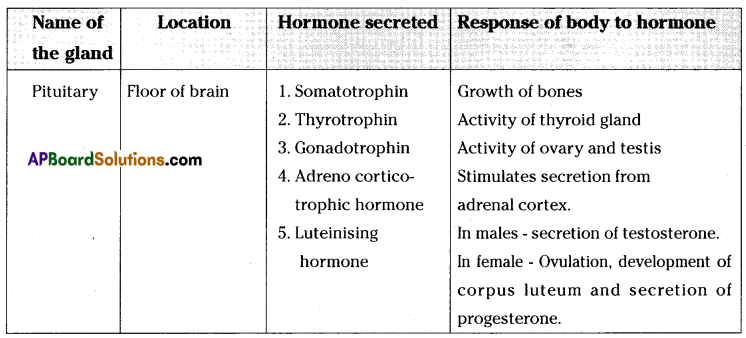
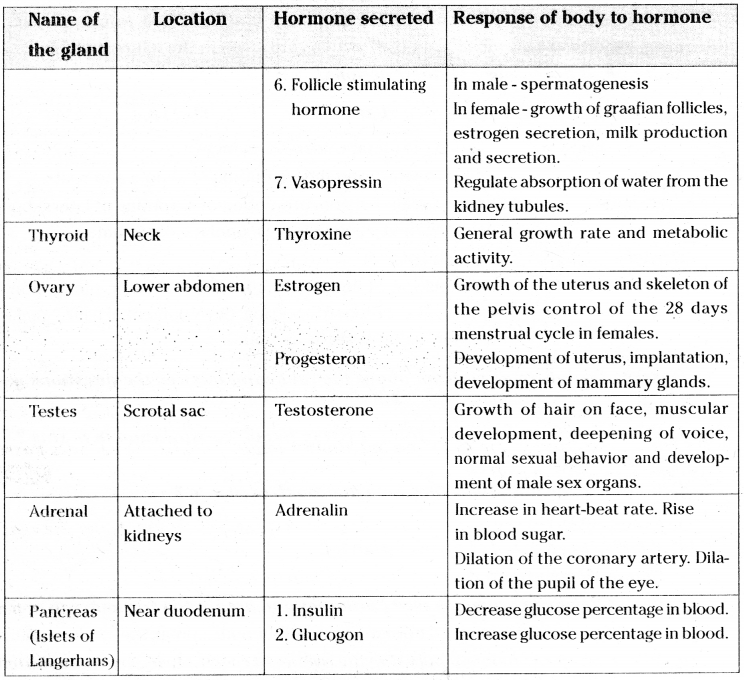
V. Communication Through Drawing, Model Making
Question 1.
Draw a diagram of Reflex area and describe the functions of different parts of Reflex arc.
Answer:

Functions of different parts of Reflex arc : Reflex arc consists of a receptor, a sensory nerve (afferent) an association neuron or inter neuron, motor nerve (effferent) and an effector organ.
| S.No. | Component of the Reflex arc | Function |
| 1. | Receptor | Receives information and generates impulses. |
| 2. | Sensory (Afferent) nerve | Carries information from the receptor to the inter neurons in the spinal cord. |
| 3. | Inter neurons | Processes’ the information and generates responses. |
| 4. | Motor (efferent) nerve | Carries the information from the spinal cord to the effector organ. |
| 5. | Effector organ | Receives the information from the efferent neuron and shows the appropriate response. |
Question 2.
Draw a diagram of a plant showing phototropism. Explain why plants possess such type of response.
OR
A plant which grows near a window bends towards sunlight. Write the reason for it.
Answer:
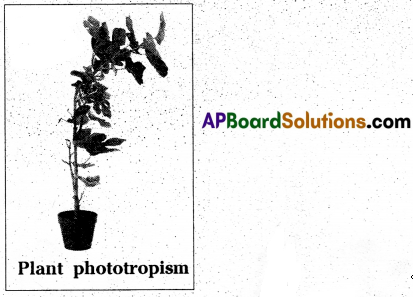
- The response of a plant to light is called phototropism.
- The plant stem responds to light and bends towards it due to the action of auxin hormone.
- When the light falls only on the right side of the stem, then the auxin hormone collects in the left side of the away from light. This is because auxin hormone prefers to stay in shade.
![]()
Question 3.
Draw the diagram of afferent nerve and label the parts.
Answer:

Question 4.
Draw the neuron which carries messages from brain / spinal cord to muscles.
Answer:

Question 5.
The diagram given below depicts the cross-section of the spinal cord. Label the parts.
Answer:
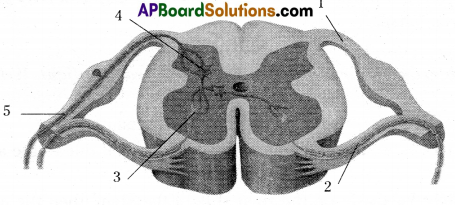
Answer:
1. Dorsal root
2. Spinal nerve
3. Ventral horn
4. Dorsal horn
5. Motor nerve
Question 6.
Draw a block diagram of different nerve pathways.
Answer:
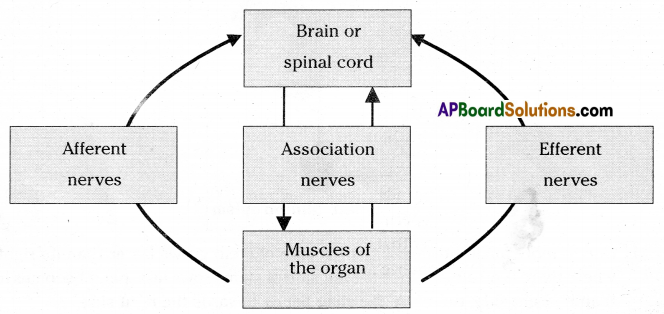
VI. Appreciation And Aesthetic Sense, Values
Question 1.
How will you appreciate the co-ordination among different organs of your body?
Answer:
- When you crossing a road, eyes and ears will see and listen to the voice.
- Through brain and motor nerve, legs will receive information to cross the road.
- With help of eyes, ears, legs, hands and body (co-ordinated by brain, spinal cord, sensory nerves and motor nerves) you can cross road safely.
- If co-ordination misses among different organs of our body, you may not complete task successfully.
VII. Application To Daily Life, Concern To biodiversity
Question 1.
How does our body maintain blood sugar level?
Answer:
- The timing and amount of hormone released are regulated by feedback mechanisms.
- When the sugar levels in blood rise, they are detected by the cells of the pancreas which respond by producing more insulin.
- If the blood sugar level falls, insulin secretion is reduced.
![]()
Question 2.
Many youngsters in our state are dying with head injury when they meet with bike accidents i.e. damage to brain. To motivate people to wear helmet, write slogans.
Answer:
- Wear helmet – Save life.
- Human brain is very precious – Save it by wearing helmet.
- Youngsters – Helmet is your life guard.
(It is open ended question. You can add some more slogans based on concept.)